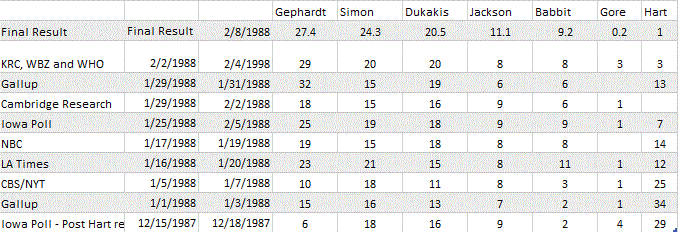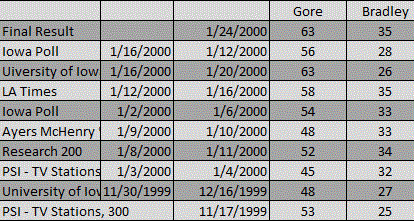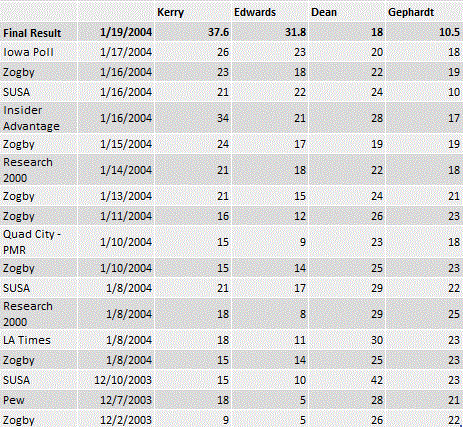Thanks to fladem for another in-depth look at Iowa caucus polling. In case you missed it, read his first post in this series: A Deep Dive into Iowa Caucus History. -promoted by desmoinesdem
This is a follow up I posted about two months ago about Iowa caucus polling. This piece is going to look at two things:
1. A review of polling as it gets close to Iowa polling.
2. A look at some individual races.
I am going to specifically avoid looking at races involving social conservatives – I will dive into that data later this week.
Let’s start with the overview. First, a database of Iowa polling is here. In all honesty I think I can say the data in this collection is the best publicly available anywhere. It was A LOT of work. Please credit me if you use the data.
This table is amazing – and why you should be VERY careful about Iowa polling this far out. There have been twelve contested Iowa Caucuses since 1980. The key take aways from this are:
1. Fewer than half of the leaders in Iowa 45 days from the Iowa caucus actually won caucuses.
2. Even more importantly, the current polling isn’t very predictive of a candidate’s final result.
Notice the number for R squared. R squared tells us how much of the final result in Iowa can be explained by how well they poll at a point in time. So in this table polls taken 45 days from the Iowa Caucuses have an R squared of .52. That means that 52 percent of a candidate’s final result can be explained by how they do in polling 45 days out. It is an amazing number: what that number is really telling us is that about half of the final result in Iowa is a result of events in the last 45 days of the campaign.
Let’s look at some of the individual races that shows significant movement in Iowa in the last 60 days of the campaign. Some lessons from these campaigns that seem relevant in 2016
1. Front runners can fall very hard, very fast (see 1980, 1988, 2004)
2. Beware two-way fights in Iowa: they can open the door for other candidates (2004)
3. The establishment matters – it can take down candidates in Iowa that it is afraid of: 1980 (Ronald Reagan), 1988 (Gary Hart), 2004 (Howard Dean), and 2012 (Newt Gingrich). Of course, we will see cases where the establishment loses – see the forthcoming discussion on social conservatives.
1980
There were far fewer polls taken during the 1980 cycle, compared to now. There was little reason eight weeks out to think Reagan was in trouble in Iowa. It is worth remembering that in 1980 many establishment Republicans did not regard Reagan as electable or safe: the lesson of Barry Goldwater and 1964 was still fresh in many people’s minds.
1988
No one believed Hart was really going to win when he got back in the race. And yet in Iowa his lead was significant.
In a loose way there might be a parallel to Donald Trump. Virtually everyone I know with experience in politics believes Trump will collapse in the end. This race provides an example of one where this happened.
It is worth nothing that Hart’s lead in Iowa collapsed faster than his national polling did. Similarly, while Trump’s national lead is growing, he is behind in Iowa and his lead in New Hampshire is fall smaller than his national lead. I liken that to the canary in the coal mine: where the race is engaged Trump is far less formidable.
2000
The Al Gore/Bill Bradley race has obvious parallels to the Bernie Sanders/Hillary Clinton race. In a later piece I will look at this more carefully. What I find interesting, though, are two things:
Bradley never got above 40 during the last 60 days of the race. In this sense, Sanders has run a far more impressive Iowa campaign than Bradley did.
There was a consistency in the polling in 2000 in both Iowa and New Hampshire. Bradley often led Gore in New Hampshire polling before Iowa voted, but he did so because he did well among independents, and independents can vote in New Hampshire. But in many ways the Iowa polling in 2000 was more revealing than the New Hampshire polling: it suggested a fundamental weakness in Bradley’s appeal to rank and file Democrats.
Sanders does not appear at this point to have as great a weakness.
2004
The 2004 race can be read a number of ways. First, it shows very clearly how much can change: John Edwards went from the high single digits to over 30 percent in a flash, and John Kerry went from the mid-teens to the mid 30s. But another is worth highlighting.
Much of the fight in the last month was between Dick Gephardt and Howard Dean, who hammered each other with negative advertising. Both candidate’s unfavorable numbers rose, which contributed to the collapse in their support.
Again, there is a pretty obvious parallel to the current GOP fight. I have little doubt that opponents are going to open up on Ted Cruz now that he leads – and it doesn’t take too much to see a way between Trump and Cruz emerging. Mike Huckabee took the Iowa lead about the same time Cruz has, and his numbers didn’t change much after he did.
More to come!





